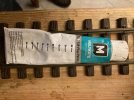Greg Elmassian
Guest
Not to be argumentative, but the process and cost of embedding metal in the ties and then making electrical connection has to have power as the primary objective in my opinion. That swivel joint is not a large amount of conductive surface.
But anyway, there's all kinds of fixes and things you can do if there are issues.
Greg
But anyway, there's all kinds of fixes and things you can do if there are issues.
Greg

